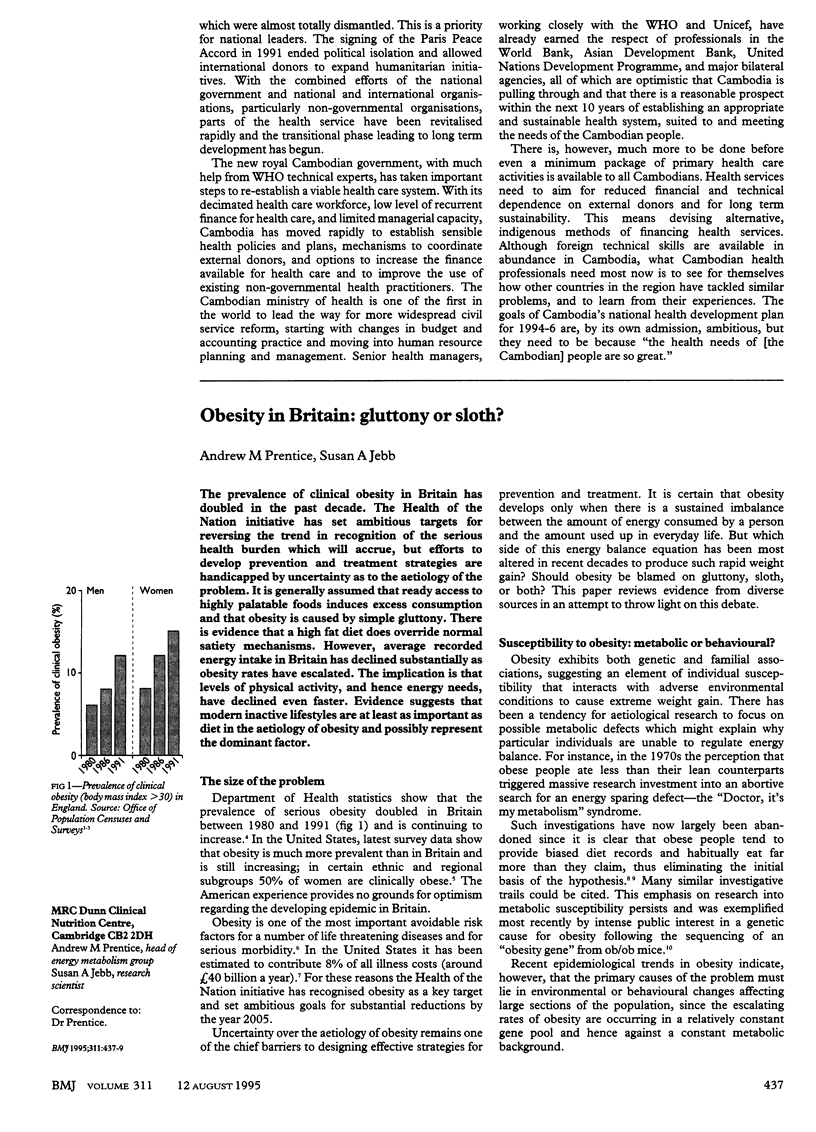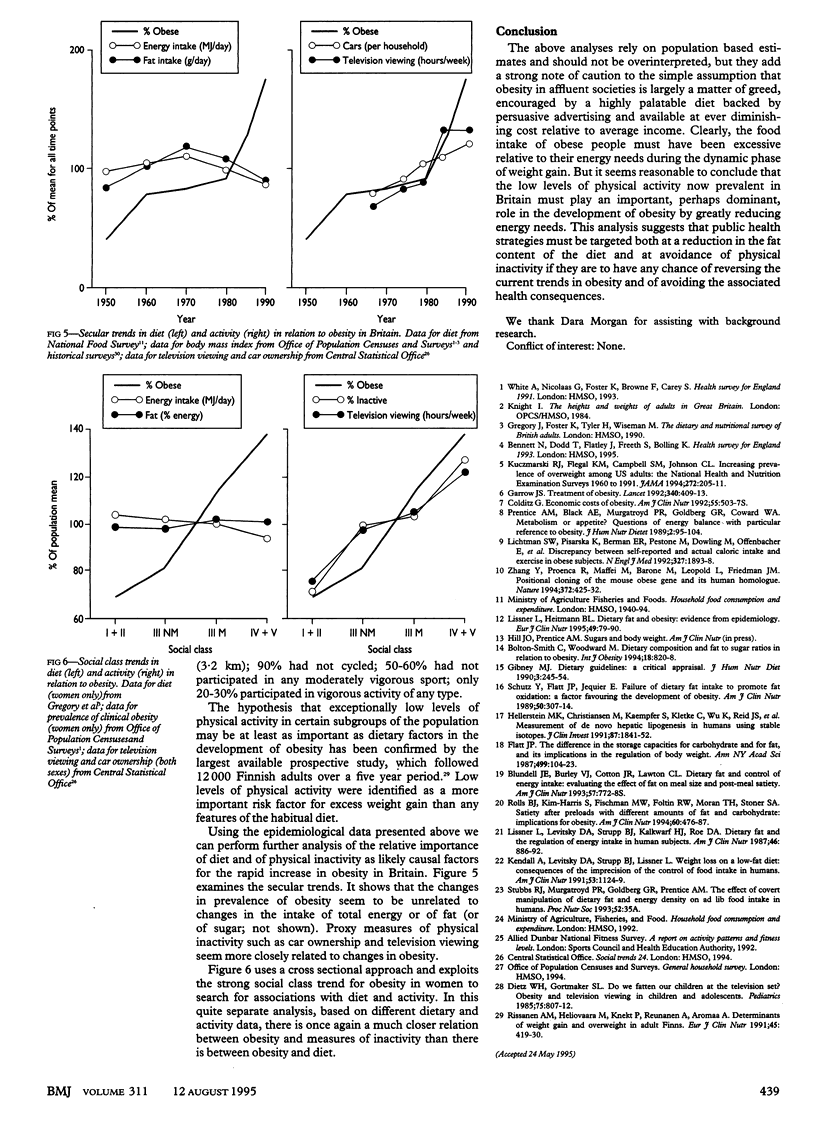Abstract
The prevalence of clinical obesity in Britain has doubled in the past decade. The Health of the Nation initiative has set ambitious targets for reversing the trend in recognition of the serious health burden which will accrue, but efforts to develop prevention and treatment strategies are handicapped by uncertainty as to the aetiology of the problem. It is generally assumed that ready access to highly palatable foods induces excess consumption and that obesity is caused by simple gluttony. There is evidence that a high fat diet does override normal satiety mechanisms. However, average recorded energy intake in Britain has declined substantially as obesity rates have escalated. The implication is that levels of physical activity, and hence energy needs, have declined even faster. Evidence suggests that modern inactive lifestyles are at least as important as diet in the aetiology of obesity and possibly represent the dominant factor.
Full text
PDF


Selected References
These references are in PubMed. This may not be the complete list of references from this article.
- Dietz W. H., Jr, Gortmaker S. L. Do we fatten our children at the television set? Obesity and television viewing in children and adolescents. Pediatrics. 1985 May;75(5):807–812. [PubMed] [Google Scholar]
- Flatt J. P. The difference in the storage capacities for carbohydrate and for fat, and its implications in the regulation of body weight. Ann N Y Acad Sci. 1987;499:104–123. doi: 10.1111/j.1749-6632.1987.tb36202.x. [DOI] [PubMed] [Google Scholar]
- Garrow J. S. Treatment of obesity. Lancet. 1992 Aug 15;340(8816):409–413. doi: 10.1016/0140-6736(92)91481-m. [DOI] [PubMed] [Google Scholar]
- Hellerstein M. K., Christiansen M., Kaempfer S., Kletke C., Wu K., Reid J. S., Mulligan K., Hellerstein N. S., Shackleton C. H. Measurement of de novo hepatic lipogenesis in humans using stable isotopes. J Clin Invest. 1991 May;87(5):1841–1852. doi: 10.1172/JCI115206. [DOI] [PMC free article] [PubMed] [Google Scholar]
- Kendall A., Levitsky D. A., Strupp B. J., Lissner L. Weight loss on a low-fat diet: consequence of the imprecision of the control of food intake in humans. Am J Clin Nutr. 1991 May;53(5):1124–1129. doi: 10.1093/ajcn/53.5.1124. [DOI] [PubMed] [Google Scholar]
- Kuczmarski R. J., Flegal K. M., Campbell S. M., Johnson C. L. Increasing prevalence of overweight among US adults. The National Health and Nutrition Examination Surveys, 1960 to 1991. JAMA. 1994 Jul 20;272(3):205–211. doi: 10.1001/jama.272.3.205. [DOI] [PubMed] [Google Scholar]
- Lichtman S. W., Pisarska K., Berman E. R., Pestone M., Dowling H., Offenbacher E., Weisel H., Heshka S., Matthews D. E., Heymsfield S. B. Discrepancy between self-reported and actual caloric intake and exercise in obese subjects. N Engl J Med. 1992 Dec 31;327(27):1893–1898. doi: 10.1056/NEJM199212313272701. [DOI] [PubMed] [Google Scholar]
- Lissner L., Heitmann B. L. Dietary fat and obesity: evidence from epidemiology. Eur J Clin Nutr. 1995 Feb;49(2):79–90. [PubMed] [Google Scholar]
- Lissner L., Levitsky D. A., Strupp B. J., Kalkwarf H. J., Roe D. A. Dietary fat and the regulation of energy intake in human subjects. Am J Clin Nutr. 1987 Dec;46(6):886–892. doi: 10.1093/ajcn/46.6.886. [DOI] [PubMed] [Google Scholar]
- Rissanen A. M., Heliövaara M., Knekt P., Reunanen A., Aromaa A. Determinants of weight gain and overweight in adult Finns. Eur J Clin Nutr. 1991 Sep;45(9):419–430. [PubMed] [Google Scholar]
- Rolls B. J., Kim-Harris S., Fischman M. W., Foltin R. W., Moran T. H., Stoner S. A. Satiety after preloads with different amounts of fat and carbohydrate: implications for obesity. Am J Clin Nutr. 1994 Oct;60(4):476–487. doi: 10.1093/ajcn/60.4.476. [DOI] [PubMed] [Google Scholar]
- Schutz Y., Flatt J. P., Jéquier E. Failure of dietary fat intake to promote fat oxidation: a factor favoring the development of obesity. Am J Clin Nutr. 1989 Aug;50(2):307–314. doi: 10.1093/ajcn/50.2.307. [DOI] [PubMed] [Google Scholar]
- Zhang Y., Proenca R., Maffei M., Barone M., Leopold L., Friedman J. M. Positional cloning of the mouse obese gene and its human homologue. Nature. 1994 Dec 1;372(6505):425–432. doi: 10.1038/372425a0. [DOI] [PubMed] [Google Scholar]


